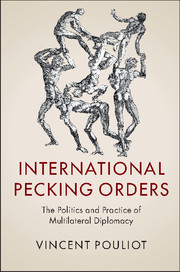Book contents
- Frontmatter
- Contents
- List of figures
- List of tables
- Preface and acknowledgments
- List of abbreviations
- Introduction: All the world's a stage
- Part I Situations
- Part II Dispositions
- 3 The diplomatic sense of place
- 4 A working consensus: the negotiation of the 2010 Strategic Concept and the NATO pecking order
- Part III Relations
- Part IV Positions
- Conclusion: The “miracle” of multilateral pecking orders
- Appendix: Research design, methods and data
- References
- Index
4 - A working consensus: the negotiation of the 2010 Strategic Concept and the NATO pecking order
from Part II - Dispositions
Published online by Cambridge University Press: 05 March 2016
- Frontmatter
- Contents
- List of figures
- List of tables
- Preface and acknowledgments
- List of abbreviations
- Introduction: All the world's a stage
- Part I Situations
- Part II Dispositions
- 3 The diplomatic sense of place
- 4 A working consensus: the negotiation of the 2010 Strategic Concept and the NATO pecking order
- Part III Relations
- Part IV Positions
- Conclusion: The “miracle” of multilateral pecking orders
- Appendix: Research design, methods and data
- References
- Index
Summary
NATO is the archetype of a multilateral organization structured by very strong patterns of pecking order. Everything takes place as if each state representative knew its place in the distribution of ranks and roles around the multilateral table. As I show in this chapter, at the North Atlantic Council (NAC) the practice of diplomacy is structured by a largely unspoken yet very real hierarchy of standing in which some ambassadors (and the countries they represent) weigh more than others. The anchoring practice of consensus is structured by a deeply embodied sense of place on the part of ambassadors. Thanks to this working consensus on the distribution of ranks and roles, open spats – such as during the 2008 Bucharest Summit, when France and Germany openly challenged the United States (US) on future enlargements – are relatively rare occurrences in the Alliance's long history.
To be as clear as possible, my argument is not that the Alliance is free from politics – quite the contrary. I contend that NATO's working consensus is the result of intense political work and social stratification. But these politics often hide from sight in Brussels because of the fact that the pecking order operates through the embodiment of the sense of place. Indeed, what is peculiar about this multilateral organization is that, while a “contentious alliance” by some accounts, its internal rifts get systematically solved through a non-violent politics that remains mostly hidden from public sight. This is the story that I tell in this chapter: At first a highly contentious matter, the negotiation of the 2010 Strategic Concept (StratCon) saw every national delegation in Brussels and its capital gradually brought back into the fold, producing a document with all the “gloss of harmony.”
This hard political work is all the more intriguing as, formally, Alliance decision-making rests on sovereign equality and consensus, which technically endows each member with a veto. How is it possible for a twenty-eight-members organization making its decisions consensually to function as smoothly, at least in appearance, as NATO does? From a political point of view, consensus is eminently puzzling, as the parity in participation that it would seem to presume clashes with the social prevalence of domination. To make sense of this, I show how Alliance diplomacy rests on various practices generative of social stratification.
- Type
- Chapter
- Information
- International Pecking OrdersThe Politics and Practice of Multilateral Diplomacy, pp. 86 - 116Publisher: Cambridge University PressPrint publication year: 2016



